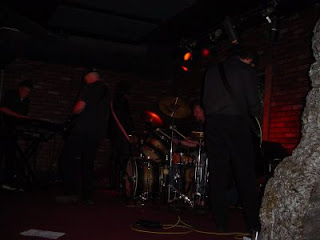At this point in time, Sun Ra's music is not too widely separated from many genres of American music. Just about every music scene, in some way or form, owes a debt to the pursuits of him and the long-term members of his Arkestra. So many Jazz, Rock, Funk, Ambient, New Age, etc. artists utilize modes, elements or methods that Sun Ra had likely touched upon long beforehand. Of course, this is a well known and well documented fact. I can think of a few whole web-sites and at least one print zine that specialize in all things Ra. That said, I consider myself a long time fan of his music and cosmology, and look back with great fondness to the Arkestra show I attended at Slim's in San Francisco in the early 1990's. His music is always worth checking out, and very often worthy of return listens.
Dance of the Living Image consists of rehearsal recordings from a 1974 Arkestra residence in the San Francisco Bay Area. It is Volume 4 of a series called
The Lost Reel Collection, issued by the label Transparency. To their credit, Transparency have let the tapes exist as recorded, having only done some remastering for the sake of improved sound quality. And how does it sound? Let's just say that if you're looking for the more frenetic Arkestra sounds, you will be disappointed. These recordings feature a band working out tunes at a very relaxed pace. This gives the CD's a nice, warm mood. Instrument sections weave in, sometimes drop out, and interact loosely. This is all done with Ra leading from his electric organ. He plays chord changes or themes, and then lets the band vamp around them. During the longer vamps, the listener can be easily pulled into the trance states that live Arkestra performances so effectively induced.
Ra sounds really cool in his band leading approach. If there were any Buddy Rich-style control freakouts, they did not make it onto this tape. Background dialog can be heard at times, presumably coming from various players as they figure their parts out, but there are never any admonitions from the leader to shut up. He just keeps playing, occasionally calling out chord changes.
His organ playing is cool and spacey, both in the way notes are played in sequence and in the cosmic tones he coaxes from it. It seems to me that he spent a
lot of time investigating tonal combinations and chord sequences. I'll take Sun Ra's Music of the Spheres over just about any other composer's. I can imagine a day when his pieces will be performed by symphonies as such.
Other sound delights come from the classic, and for Ra, indispensable, horns of John Gilmore, Marshall Allen, and Eloe Omoe. These smart, talented, men, who stayed with Sun Ra for so long, give huge validation to his prowess as a band leader. On Dance of the Living Image, you can hear them work out their chemistry, and it's a glorious sound. Rich, thick, heavy saxophones, played spacey and stately by Ra's dependable crew.
Despite the fact that he was sometimes derided as an Avant Garde huckster (see if you can find Abbey Lincoln's lowest common denominator description of Ra and try not to wretch), one thing that set him aside from the Avant Garde was his rhythmic sensibility. Most Arkestra tunes and recordings feature drumming and bass playing that is really simple in it's approach. Unlike in the Avant or even in Be-Bop, Sun Ra slowed down and really simplified the rhythm section's playing. Depending on your tastes, this can be annoying or sublime. I'm obviously inclined to go with the latter feeling. Living Image is filled with tranced-out, primitive drumming and bass playing, and it's really great.This approach grounds the tunes and vamps wonderfully, all the while giving the listener a pulse to follow. Sun Ra's simple conception here works in an almost Rock fashion.
Speaking of Rock, there is even some great electric guitar playing on Disc One of this two disc set. The player gets a nice wah-wah sound going, reminiscent of Ron Ashton at his most spaced-out moments on the first Stooges record (imagine what Scott and Ron Ashton could have done with Sun Ra!). It's a great addition to the sound, and I wish there were more of it on the discs.
Dance of the Living Image most likely would not interest the casual Jazz fan, but anyone interested in Sun Ra's repertoire, or the process of creating music for that matter, would have a lot to appreciate there. I plan on checking out a lot more stuff from Transparency.
